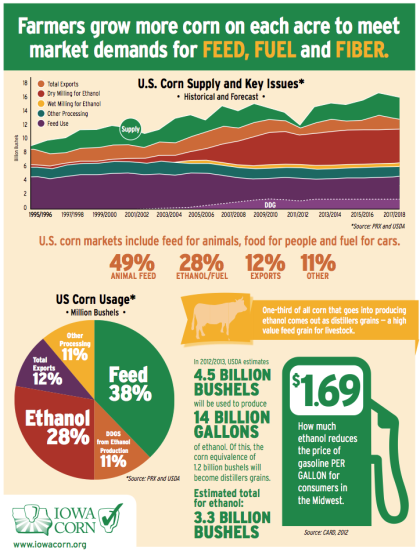Filed under: Ag education, Ag promotion, Biofuels, ethanol, Farm, Farm Bureau, science | Tags: Agriculture education, car, cars, compressed natural gas, diesel, diesel fuel, ethanol, ethanol producers, farm, Farm Bureau, gas, gasoline, liquefied petroleum gas, machines, transportation
 One of the sessions I attended at the AFBF meeting in Nashville was a General Motors seminar on the future of motor vehicles. Since they were talking to a farm audience they mostly talked about light trucks, but automotive and heavy truck technology was also touched on. One of the items that they made plain was that the gasoline technology was not going away just yet, but they were gearing up for the future.
One of the sessions I attended at the AFBF meeting in Nashville was a General Motors seminar on the future of motor vehicles. Since they were talking to a farm audience they mostly talked about light trucks, but automotive and heavy truck technology was also touched on. One of the items that they made plain was that the gasoline technology was not going away just yet, but they were gearing up for the future.
The biggest driver in the future of motoring was the higher mpg demands of both the public and government in this era if higher fuel prices. The problem with most of the new technologies is getting the fueling stations out for use. Although Compressed Natural Gas (CNG) and Liquefied Petroleum Gas (LPG) are available for larger fleets where they can come to a base station every night, long distance motoring is still going to require a liquid motor fuel. The same is true of hydrogen and electric vehicles, we know how to make them, we just cannot keep them on the road once they get away from fast refueling connections. To bridge the gap until we get refueling stations set up for these fuels we are still going to have to rely on liquid fuels like diesel, gasoline and ethanol.
 Despite where you stand on ethanol, the automotive industry is planning on using greater amounts of it in fuels for the foreseeable future. If they are to meet the government mpg guidelines they have no choice. Understandably the growers of ethanol feedstocks are all in favor of this increase.
Despite where you stand on ethanol, the automotive industry is planning on using greater amounts of it in fuels for the foreseeable future. If they are to meet the government mpg guidelines they have no choice. Understandably the growers of ethanol feedstocks are all in favor of this increase.
While today we in agriculture are fighting a battle to keep E-15 approval, automotive manufacturers are gearing up for E-30. They are telling the ethanol producers that it will happen. Automobile manufacturers need the higher octane that ethanol gives to produce the higher performance engines of the future.
I don’t expect Big Oil to give up this battle without a fight. They want to keep us dependent on gasoline and diesel for as long as possible. They are already breaking down the gunkier oils that they used to throw away to meet demand. This costs more money, money they are getting from government subsidies and from us in higher prices. In the mean time, automotive manufacturers are planning for a future that uses less gasoline. They can already see a future of less oil usage, and it is something that I have waited for for a long time.
Michael
4 Comments so far
Leave a comment


Hi Michael, I think Big Oil is already hedging their bets in moving into alternative energy research and development. They know that fossil fuels will dominate for the next two or three decades but that alternative liquid fuels, and other forms of energy will take an increasing percentage of the market. You are right that the single impeding factor to the proliferation of alternative fuels is the build out of a refueling infrastructure. Right now EVs get charged at home overnight but in Europe there is the start of an infrastructure build out. In North America only California has EV recharge sites that are not in peoples’ garages but only Tesla S Models can use them.
Comment by lenrosen4 January 24, 2013 @ 3:08 pmIt’s like the early days of the auto. The demand is there, but the world is not ready for the future.
Comment by Michael January 25, 2013 @ 11:06 amNations seem to sanction transportation fuels based on their respective natural resource bases. Brazil, tropical center of a highly productive sugar industry, has a focus on ethanol. The US, which once was able to meet most domestic fuel demand with in-country oil production, focuses on gasoline as if it were still 1970. China, without much of either oil or sugar, has decided to go for methanol as the ‘official liquid transportation fuel’ of the future. The logic here is that methanol is a straightforward output of Coal To Liquid (CTL) processing and they have coal-a-plenty.Yes we know: methanol is toxic. But so is gasoline (a major constituent of gasoline is benzene, a known human carcinogen). Plus, don’t forget to account for this USEPA risk analysis , from we excerpt the following information: – “Gasoline-ignited fires in 1986 involving cars, buses, or trucks resulted in 760 deaths, 4,100 serious injuries, and $215 million in property damage. Projections indicate that casualties would drop dramatically if methanol were substituted for gasoline as the country’s primary automotive fuel. Looking just at vehicle fires in which gasoline is the first material to ignite, a switch to methanol could save an estimated 720 lives, prevent nearly 3,900 serious injuries, and eliminate property losses of millions of dollars per year”.
Comment by Heidi J. Callahan February 5, 2013 @ 3:43 pmFew realize that GM concept cars as late as the 1950’s still expected to use methanol as a fuel source. Their Buick line had two concept cars in 1951 that had both gas and methanol tanks.
Comment by Michael February 6, 2013 @ 12:53 pm